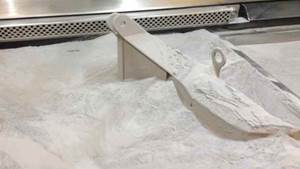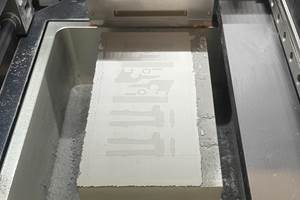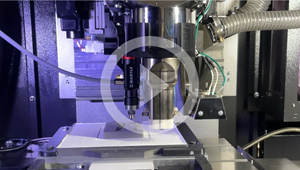AddiTec Acquires Elem Additive Solutions From Xerox
The acquisition enables AddiTec to expand its reach into liquid metal printing technology, opening up new opportunities for growth.
AddiTec’s Performance AMRC-P additive system is a forward-deployable robot cell rated for reactive materials. Photo Credit: AddiTec
AdditTec, a provider of metal additive manufacturing (AM) technology, has acquired Elem Additive Solutions from Xerox Holdings Corp. The acquirement of Elem Additive Solutions follows AddiTec’s efforts to focus on the extension of its technology portfolio to increase industrial adoption of AM.
The acquisition will enable AddiTec to expand its reach into liquid metal printing (LMP) technology, strengthening existing capabilities, opening up new opportunities for growth and enhancing the ability to serve the growing AM industry.
Since its founding, Elem Additive Solutions has been a provider of LMP technology and a key part of Xerox’s culture of innovation. From commercializing the first industrial liquid metal 3D printer to deploying it on a naval vessel, the company says it has had a history of firsts. The company’s liquid metal 3D printer, ElemX, was developed to be a safer and simpler solution, addressing supply chain resiliency for transportation, aerospace, defense and industrial manufacturing.
The shared mission and strong technological synergies between AddiTec and Elem Additive Solutions creates an opportunity to continue to innovate to the next level of liquid metal printing.
“The Elem Additive team has seen tremendous success since the organization was stood up nearly four years ago,” says Steve Bandrowczak, Xerox CEO. “In evaluating partners for this sale, it was critical we found a company with a shared mission that would sustain and advance Elem Additive’s innovation into the future. We are confident that AddiTec is the right partner and look forward to witnessing both teams’ shared success on the road ahead.”
Additec is enthusiastic about the acquisition completion. “This acquisition is a significant step for our company, we see incredible value in liquid metal print technology, and Elem Additive’s success supplements our growth efforts as we continue to develop new offerings and bring to market our turnkey metal additive manufacturing systems,” says Brian Matthews, AddiTec founder and CEO. “We are delighted to have acquired Elem Additive Solutions and will strive to create further innovative services and solutions for our customers with the addition of this exciting liquid metal printing technology.”
AddiTec will continue to support Xerox customers as the Elem Additive team transitions to the organization. AddiTec says it expects to continue to provide a service of excellence and success for its clients.
- Learn about AddiTec’s development of a portable additive manufacturing robot cell. The AMRC – P (Additive Manufacturing Robot Cell – Portable) is capable of printing parts up to 1.8 meters in dimension in a wide range of materials, including titanium.
- Read about the MSU’s collaboration with AddiTec to develop biocompatible bone implants. The collaboration focuses on enhancing Ti-6Al-4V implant properties by incorporating alloying elements such as Tricalcium phosphate to the Ti-6Al-4V melt pool matrix — which cannot be done conventionally.
- Check out this article about Siemens collaborating with Elem Additive Solutions. The partnership includes installation of a Xerox ElemX 3D printer at the Siemens’ Charlotte Advanced Technology Collaboration Hub in Charlotte, North Carolina.
Related Content
Postprocessing Steps and Costs for Metal 3D Printing
When your metal part is done 3D printing, you just pull it out of the machine and start using it, right? Not exactly.
Read MoreAM 101: What Is Binder Jetting? (Includes Video)
Binder jetting requires no support structures, is accurate and repeatable, and is said to eliminate dimensional distortion problems common in some high-heat 3D technologies. Here is a look at how binder jetting works and its benefits for additive manufacturing.
Read MoreHow Norsk Titanium Is Scaling Up AM Production — and Employment — in New York State
New opportunities for part production via the company’s forging-like additive process are coming from the aerospace industry as well as a different sector, the semiconductor industry.
Read More3D Printing Molds With Metal Paste: The Mantle Process Explained (Video)
Metal paste is the starting point for a process using 3D printing, CNC shaping and sintering to deliver precise H13 or P20 steel tooling for plastics injection molding. Peter Zelinski talks through the steps of the process in this video filmed with Mantle equipment.
Read MoreRead Next
Crushable Lattices: The Lightweight Structures That Will Protect an Interplanetary Payload
NASA uses laser powder bed fusion plus chemical etching to create the lattice forms engineered to keep Mars rocks safe during a crash landing on Earth.
Read MoreProfilometry-Based Indentation Plastometry (PIP) as an Alternative to Standard Tensile Testing
UK-based Plastometrex offers a benchtop testing device utilizing PIP to quickly and easily analyze the yield strength, tensile strength and uniform elongation of samples and even printed parts. The solution is particularly useful for additive manufacturing.
Read MorePostprocessing Steps and Costs for Metal 3D Printing
When your metal part is done 3D printing, you just pull it out of the machine and start using it, right? Not exactly.
Read More





















